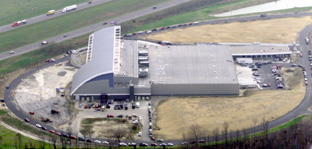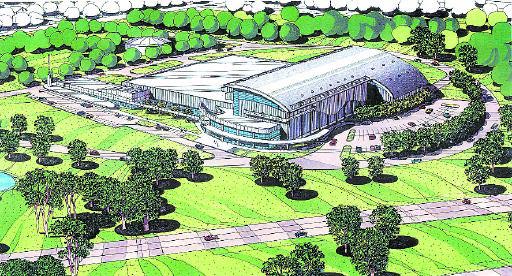Company histories --
The Dayton Daily News
| Above: DDN's historic 1910 building at Fourth and Ludlow. |
 |
Meanwhile, Cox entered the political arena and served two terms in Congress. He was elected Governor of Ohio three times. In 1920, the Democratic party nominated him for President of the United States, with Franklin Delano Roosevelt his running mate. He lost that election and returned his attention to the media business.
During the late 1940s, Gov. Cox bought out his two local competitors, the Herald and the Journal. Both papers were merged into The Journal Herald, a morning paper, in 1949.
The two papers were combined in September 1986 under the banner "Dayton Daily News and Journal Herald."
The Journal Herald name was dropped from the paper's flag on Dec. 31, 1987, and the Dayton Daily News became a morning-only newspaper on Sept. 26,1988.
When Gov. Cox died in 1957, ownership of the business passed into the hands of the three Cox children, James M. Cox Jr., Anne and Barbara. James Cox Jr. died in 1974.
The Dayton Daily News is part of the newspaper division of Cox Enterprises and employs approximately 1,200 people. Barbara Cox Anthony is chairman of the board of Dayton Newspapers, Inc., which publishes the Dayton Daily News.
On Jan. 18, 1996 Cox officals announced a reorganization of its Ohio newspapers. Operations of the Dayton Daily News and the Springfield News-Sun were combined under a single operating unit, Cox Ohio Publishing, Inc.
On Dec. 15, 1996, DDN announced plans for a $90 million printing and distribution plant to be built in Franklin. When completed in 1999 the plant would be the most technologically advanced newspaper printing facility in North America. Although printing operations would move to the new plant, most DDN departments would remain at the historic Fourth and Ludlow building.
Cox Enterprises is a major media company, with ownership of numerous newspapers, radio/TV stations and cable operations. It also is the largest operator of auto auctions in Nonh America and one of the largest in the world. Cox is a privately held company with 30,000 employees. James Cox Kennedy is chairman and chief executive officer.
Chronology:1905 -- Cox buys the Springfield Press-Republic and changes its name to the Springfield Daily News. 1908 -- Cox elected to Congress. 1910 -- New Dayton Daily News "bank" building is erected at 4th and Ludlow. 1913 -- Cox elected governor of Ohio. 1915 -- loses re-election bid. 1917 -- elected governor again. 1919 -- re-elected governor, becoming the state's first three-term governor. 1920 -- With Franklin Roosevelt as his running mate, James M. Cox is the Democratic nominee for president of the United States. He loses the general election to fellow Ohioan Warren G. Harding. 1921 -- At the end of his third term as governor, Cox returns to private life and concentrates on the newspaper business. 1923 -- Cox acquires the Miami Metropolis in Florida, changing its name to the Miami Daily News. The same year Cox buys the Canton News. 1930 -- Cox sells the Canton paper and buys the Springfield Sun. 1934-- Cox enters broadcasting, establishing Dayton's first radio station, WHIO. 1939 -- Cox acquires the Atlanta Journal and its AM radio station, WSB. 1948 -- Cox enters the new medium of television with WSB-TV in Atlanta. 1949 -- The Dayton Journal-Herald purchased by Cox; WHIO-TV goes on the air. 1950 -- Cox buys the Atlanta Constitution. 1957 -- James M. Cox dies at age 87. His son, James M. Cox Jr., succeeds him as head of the family business. 1964 -- The Cox family forms the Cox Broadcasting Corp. to run all its radio and TV operations. 1967 -- Cox Broadcasting goes into the motion picture business (its Bing Crosby Productions eventually made such movies as Ben, Walking Tall and The Reincarnation of Peter Proud. (Although Cox Broadcasting stock was publicly sold on the New York Stock Exchange, the family retained substantial ownership; Cox newspapers remained privately held). 1968 -- All Cox-owned newspapers are organized under Cox Enterprises Inc.; the same year Cox Broadcasting purchased auto auction facilities in Pennsylvania, New Jersey and Virginia. 1969 -- Cox Enterprises adds the the Palm beach Daily News, The Palm Beach Evening Times and the Palm Beach Post. 1974 -- James Cox Jr dies at the age of 71. His brother-in-law Garner Anthony (husband of James Jr's sister Barbara Cox Anthony) takes over the primary direction of the family business. 1976 -- Cox Enterprises acquires four Texas newspapers: the Austin American-Statesman, the Waco Tribune-Herald, the Port Aurthur News and the Lufkin Daily News. 1977 -- Anne Cox Chambers (also a sister of James Jr), who had been an early supporter of Jimmy Carter, becomes ambassador to Belgium in the Carter Administration; Cox Enterprises buys the Mesa Tribune in Arizona. 1978 -- Cox Enterprises buys the Longview Morning Journal and the Longview Daily News in Texas. 1979 -- The Grand Junction Daily Sentinel in Colorado is acquired by Cox. 1980 -- Cox Enterprises buys the Tempe Daily News in Arizona. 1982 -- Cox Broadcasting changes its name to Cox Communications, Inc. to refelect its position in both broadcasting and cable. 1983 -- Cox acquires the Chandler Arizonan. 1984 -- Cox buys the Yuma Daily Sun. 1985 -- Cox Enterprises purchases the outstanding public shares of Cox Communications 1986 -- The Daily News and Journal Herald are merged. 1987 -- on Dec. 31, 1987 the Journal Herald names appears for the last time on the banner. 1988 -- on Sept. 26, 1988 the Daily News becomes a morning-only paper. 1996 -- Cox reorganized its Ohio newspaper operations under a single unit, Cox Ohio Publishing, Inc. On Dec. 15, 1996, Publisher Brad Tillson announced plans for a $90 million printing and distribution plant to be built in Franklin.
1998 -- DDN celebrates its 100th year. |
